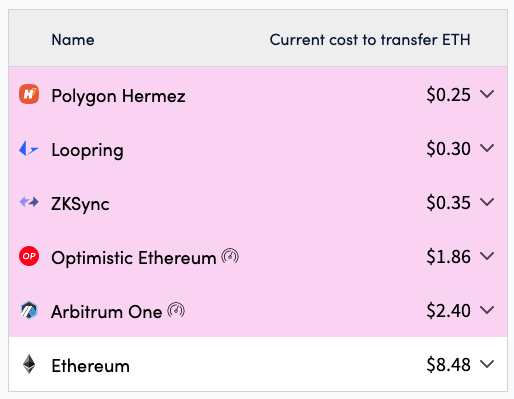Popular decentralized applications work on several networks at once. These networks can be Avalanche, Arbitrum, Solana, or one of Polkadot's EVM compatible parachains like Moonbeam. But which ones are best for building decentralized storage systems? Let's try to figure it out.
Basic requirements for a blockchain that uses decentralized storage can be formulated as following:
- It must be a public blockchain and open source. Ethereum and all its main competitors (Polygon, Avalanche, Arbitrum, etc.) are being developed within this model.
- The chosen blockchain platform must be compatible with the Ethereum Virtual Machine (EVM). This ensures that smart contracts can be deployed with minimal changes to their source code.
- The selected blockchain must have modern technical characteristics. It needs to have high performance and low transaction costs in order for scaling onto this blockchain to make economic sense.
- The chosen blockchains must have a developed community and a large user base that needs a reliable and high performance decentralized storage solution.
- It is highly desirable that on the selected blockchain bridges for the exchange of tokens are implemented with blockchains where DeNet solutions are already working. This opens up the horizons for cross-chain exchange of NFT, whose data is securely stored in the DeNet decentralized storage.
Use of a suitable blockchain in conjunction with its own high-speed network makes the DeNet solution easily scalable, and the transactions with NFT - fast and inexpensive. In particular, the DeNet Storage solution is already running on Ethereum networks, its Kovan testnet, and the Layer 2 Polygon (MATIC) scaling solution.
In the same way, DeNet smart contracts can be transferred to any other network that supports EVM (Ethereum Virtual Machine).
Let's start with the popular Layer 2 Arbitrum (ARB) solution.
Arbitrum (ARB)
Arbitrum is positioned by its developers as a layer 2 solution designed to improve the capabilities of Ethereum smart contracts - increasing their speed and scalability, as well as adding additional privacy features.
To improve performance compared to the main Ethereum network, Arbitrum uses optimistic rollup technology, which groups transactions assuming the validators are honest. This means that the Arbitrum protocol guarantees that the code will work correctly (i.e., as intended) as long as any validator is honest, helping the network to resist collusion and other forms of attack.
According to the L2Beat decision tracker at the time of writing, Arbitrum leads by a wide margin in terms of total value locked (TVL), which reflects the total amount of all funds held in the platform’s smart contracts.
This figure is due to Arbitrum's main application scenario - cross-network arbitrage, when a large number of tokens are held on the network in order to balance supply and demand in various blockchains and decentralized finance platforms.
All this and the growing popularity of the network look optimistic for deploying a decentralized storage system on it too, but Arbitrum ceases to look attractive as soon as it comes to gas prices, which have become the talk of the town and the Achilles heel of Ethereum. The price of one transaction according to L2 Fees at the time of writing is $2.40. Compare this with gas prices in other blockchains:

Thus, Arbitrum One can only compete with Ethereum itself, where gas prices for exchange transactions reach up to $40, but it is less suitable for integration tasks with a decentralized storage system and NFT, since there are more high performance blockchains with lower transaction fees.
Avalanche (AVAX)
Since its mainnet launch in 2020, the Avalanche team has been working to expand its dApps and DeFi ecosystem while allowing Ethereum-based projects like SushiSwap and TrueUSD to run on the system. The results for 2021 - a significant development of the ecosystem and the transfer of leading DeFi applications to Avalanche - allowed the blockchain to gain a foothold in the top twenty by market capitalization. At the time of writing, Avalanche is in 11th place in this indicator, although just a year ago it was only in 24th place.
At the time of writing, Avalanche's mainnet is capable of supporting 6,500 transactions per second without sacrificing scalability, but keep in mind that Avalanche is actually made up of three separate blockchains, X-Chain, C-Chain, and P-Chain, each with a specific purpose and relying on to separate consensus mechanisms. Together they give much greater performance.
For example, the exchange blockchain (X-Chain) creates and exchanges its own AVAX token and other assets and uses the Avalanche consensus mechanism - a process where all transactions are processed simultaneously - and applies random polling to ensure that transactions are correct with statistical certainty. There are also no blocks in this mechanism, which dramatically increases the speed of the protocol.
The contract blockchain (C-Chain) hosts smart contracts and decentralized applications and uses Avalanche's own EVM-like virtual machine, allowing developers to create EVM-compatible dApps.
Finally, the platform blockchain (P-Chain) coordinates the work of network validators, monitors and allows the creation of new subnets.
Technically, for decentralized storage tasks, Avalanche is one of the most interesting options. But in terms of popularity, it is inferior to blockchains such as Binance Smart Chain or Solana, which have strong support from the Binance and FTX communities, respectively.
Binance Smart Chain
Binance Smart Chain, abbreviated as BSC, was created and launched in 2019 by the popular digital asset exchange Binance, and today is already able to compete with the Ethereum network in the field of smart contracts.
BSC allows development of high-performance dApps and other applications based on smart contracts, and also has the function of cross-chain compatibility with the native Binance Chain blockchain.
BSC combines Binance Chain's high transaction throughput with Binance Smart Chain's smart contract functionality to enable low-latency, low-cost transactions, essentially addressing two major criticisms of Ethereum. However, BSC also supports the Ethereum Virtual Machine (EVM), which allows Ethereum-based applications to run on the BSC blockchain with minimal code changes.
When comparing Binance Smart Chain with Ethereum, Binance offers faster and cheaper transactions. The network has an average block time of 3.0 seconds and a throughput of 39.2 TPS, which is about three times faster than Ethereum. In terms of transaction fees, BSC charges an average of 5 gwei, which is only $0.33, and this makes BSC a significantly cheaper alternative to Ethereum.
For comparison, in Ethereum, at the time of writing this material, the fee structure is approximately the following: $8.75 for transferring ETH from one wallet to another, about $20 for transferring tokens, and more than $40 for an exchange.
One sign of BSC widespread acceptance is that the network is already overtaking Ethereum in daily transactions. On July 11, 2021, BSC processed a total of 3.2 million transactions, almost triple the 1.1 million daily transactions on the Ethereum network.
Despite the use of Ethereum in daily transactions, Binance CEO Changpeng Zhao claims that BSC will not become an Ethereum killer, being only a temporary replacement until the release of Ethereum 2.0: “BSC is more like ETH 1.8. 100% backwards compatible, faster and lower fees (97% lower),” Zhao tweeted.
However, BSC's inherent centralized nature may make it less resilient than Ethereum with its many decentralized nodes. Since Binance is the main provider of network security, its blockchain is in for a tough time if the exchange continues to be targeted by regulators around the world.
BSC is also owned by a centralized entity, which technically allows Binance to modify or censor transactions on the blockchain. This would be extremely difficult to do on the Ethereum network as it is not owned by a single entity.
Despite the high market capitalization of Binance Smart Chain, experts believe that it is unlikely to dethrone Ethereum in the near future if Ethereum 2.0 successfully rolls out and solves the main problems of the network.
Solana (SOL)
Another successful centrally supported high performance blockchain option. The Solana network was launched by the FTX crypto exchange with a claimed performance of 50,000 TPS, comparable to the Visa payment system. The developers claim that the main purpose of the network is decentralized applications for trading. In particular, one of the ambitious goals was to implement an on-chain decentralized exchange option based on the order book. At that time, there were no such decisions. But the success of the blockchain was not only trading applications, but also the means of cross-network interaction and rapid migration of capital and developers to the platform.
Solana's popularity began to grow exponentially in the second half of 2021 after the successful launch of its Wormhole communication bridge. Around the same time, NFT platforms and collections began to appear with explosive popularity. For example, Degenerate Ape Academy's own NFT series sold out its 10,000 tokens in eight minutes of launch, resulting in a record trading volume of US$2.5 billion.
Solana technically uses a combination of two consensus mechanisms: proof of stake, which rewards validators with their own SOL token according to how many validator tokens are staked, and proof of history, which keeps a record of historical transactions so the network can order and track them faster. Using this combination of consensus mechanisms increases Solana's throughput to the point that, at the time of writing, it is capable of processing around 65,000 transactions per second, which is 2,000 times faster than Ethereum and much faster than Visa. This makes the Solana network one of the most energy efficient blockchains; a recent report released by Solana Labs, the company behind the blockchain, found that a single transaction on the network uses 1,837 joules of energy, while a Google search uses 1,080 J. In comparison, even with its drastically reduced electricity costs, a transaction on ETH2 126,000 J will still be needed.
With all the pluses, Solana is not without drawbacks. Due to low transaction costs and high performance, the network sometimes runs resource-intensive applications that can slow down the network. Over the past year, Solana has experienced four major outages that shut down the network for several hours, similar to a DDoS attack.
In August, after the launch of the Degenerate Ape series, SOL traded at just $64.48, but has broken new levels several times since hitting its most recent all-time high of $260. Since then, the price of the token has corrected significantly, including due to the network failures described above.
In January 2021, Solana's native blockchain cryptocurrency (SOL), with a market capitalization of approximately $46 billion at the time of this material's publication, ranked fifth in the top 10 cryptocurrencies, according to CoinMarketCap.
Polkadot (DOT)
Polkadot is positioned by developers as the internet of blockchains. By itself, the Polkadot network, as well as its sister network Kusama, is not capable of running smart contracts. This is the type of network that the developers call the zero layer, that is, it is a blockchain that processes transactions and transfers application states between networks, and nothing more.
However, so-called “parachains” are connected to the Kusama and Polkadot networks, each of which can have its own characteristics. At the same time, the number of parachains that will carry the EVM will be quite large, and as the number of ecosystem users increases, it will become clear which of them will be the most popular.
At the time of writing, Moonbeam is the leader among EVM-compatible parachains, which is positioned by developers as a platform for smart contracts designed to work both in the Polkadot ecosystem and beyond.
It was no coincidence that Moonbeam won the first parachain slot on Polkadot. For developers, Moonbeam is positioned as the leading gateway for popular EVM-based DApps planning to launch on Polkadot, and the team describes it as 'the easiest entry' into the Polkadot ecosystem.
Conclusions
The networks described above are only the most visible of the whole army of blockchains with which the DeNet solution can be integrated. Most of them either already provide all the necessary conditions for the successful launch of a decentralized storage system based on them, or are close to it.
In terms of performance, the Avalanche and Solana blockchains are the most promising. The main advantage of the BSC blockchain can be considered its huge user base and strong support from the leading crypto exchange. A promising direction is the deployment of a storage system on one of the parachains of the Polkadot ecosystem, such as Moonbeam.
In any case, when choosing a network, you also need to focus on its community and which applications from among those launched or about to launch are in dire need of a decentralized storage solution. Therefore, in the next article, we will talk about what types of blockchain applications will benefit from integration with the DeNet decentralized storage network.









